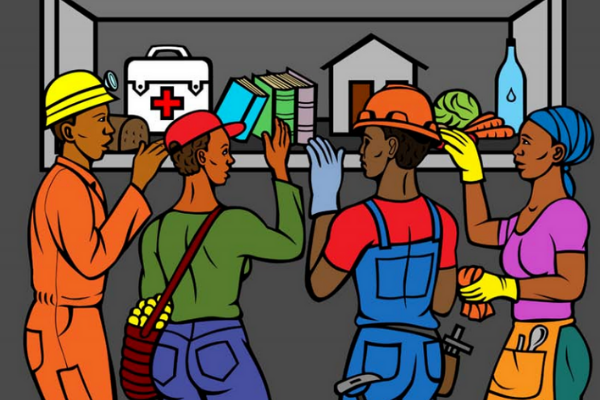George Mthethwa, Educator and Facilitator in LRS Collective Bargaining Support Programme, gives his take on how the covid-19 pandemic has affected negotiations and why trade unions should practise foresight to shape the future of the movement.
What is the impact of the covid-19 pandemic on collective bargaining?
Collective bargaining requires strong and well-organised trade unions. The covid-19 pandemic hasn’t changed this view for unions in South Africa. The collective agreement is now more important than ever as a tool for countering any threats to workers’ rights and for pressuring all employers to respond to the needs of workers during the crisis.
Equally important is information sharing among trade unions. We’ve been assisting our 15 member unions (and other worker formations) with such information sharing to strengthen cross-industry alliances. Unions are then able to compare the information with what is happening at workplaces and verify the claims of the companies.
Together with the unions, the LRS maintains free to access online databases: the Actual Wage Rates Database, Agreements Database and Multinational Corporations Database. The databases are repositories of wage information, collective agreements and company information, respectively. We collect close to 700 agreements from unions annually. But the pandemic affected our ability to collect agreements from the unions this year. That and the disrupted bargaining season for unions means there might be fewer agreements signed in 2020.
More unions are approaching our organisation with bargaining information requests, particularly advice on dealing with retrenchments.
Workers were already hurting from the existing challenges in the labour sector. Their situation has been worsened by the coronavirus response measures, which have harmed the economy, businesses and the regional supply chains. Three million people have reportedly lost their jobs since the start of the covid-19 lockdown. There’s now tension in workplaces as workers contend with a slew of issues, including long hours, lack of personal protective equipment, wage cuts, the threat of retrenchment and wage freezes. For instance, about 1.3 million workers in the public sector don’t know when they will get their salary increases. The parties met and tried to resolve the wage issue but failed to reach an agreement. The matter was referred to arbitration, but the government wanted the process to be delayed. The public service unions took the government (the employer) to court for reneging on the 2018 wage agreement. The government lost the case and the matter was referred to arbitration. We will continue to see all sorts of tactics from both public and private sector employers. So, trade unions have their work cut out for them.
How can unions strengthen their bargaining positions in retrenchment processes?
The communications I have seen from companies to unions referred to financial constraints and retrenchments or restructuring due to the pandemic. One of the big retailers is implementing new systems by getting rid of specific positions and using low prices to attract more shoppers during the lockdown. Some companies are using the crisis to retrench their workers. The LRA’s Section 189, which permits employers to dismiss employees for operational requirements, has long been used as a tool to punish trade unions. Under Section 189, the union has no power to stop a retrenchment decision by a company. The only recourse for the union is to call a strike or refer the matter the labour court, which is essentially a delaying tactic. The bottom line is that workers are bearing the worst brunt.
I would emphasise the need for unions to be informed role players during consultations with bosses and at the bargaining table. Company information is extremely useful for any negotiator facing a retrenchment case right now. Find out how much revenue and profits the company made recently and in the last few years. How much are the bosses earning and what’s the wage gap? Which jobs are targeted for retrenchment? Essentially, know all the bargaining benchmarks to help you craft a decent response to the inevitable process.
My advice is to make the retrenchment costly for the employer. You could demand a severance package of up to six weeks, for example. Or that the company pays study fees to the employees facing retrenchment.
Remain alert and interrogate the financial distress claims by especially big companies. If the company made a profit in the last three years, can it claim ‘catastrophic’ losses over three months and start retrenching workers for the lack of an alternative plan? The big companies can’t hide behind the covid-19 pandemic to get rid of workers or renege on existing collective agreements. We know some companies have been making huge profits from our most recent Directors’ Fees report. We know there are challenges due to the pandemic, but workers and their representatives must be included in a proper consultation process. We also know the impact of the pandemic on small businesses is disproportionate. Still, smaller companies must be ready to prove that their claims of distress are genuine.
One of the unions I worked with recently said its members in vulnerable work received communication from their employer – a small business – instructing them to go to UIF (not the Covid-19 TERS) and claim their money. But the communication wasn’t clear if the workers had been dismissed, and bosses did not consult the union. The union has asked the company to have a proper consultation process. If a company is genuinely in distress it should welcome a consultation process with the union and the workers to explore ways of saving the company and jobs.
What kind of non-cash demands could a union put forward for bargaining during the covid-19 pandemic?
If the company can’t afford to give wage increases, the union could put forward non-wage demands. Some examples are mandatory (and quality) personal protective equipment, subsidised transportation (for the period of crisis) and food allowance (to assist workers who are hard hit by hunger).
With unions increasingly using online communications tools and platforms for organising and bargaining, technology offers opportunities for non-cash demands. Demand for technology and equipment, as well as training for shop stewards on how to use the supplied technology. The employer must sit down with unions and explore the available resources for mutual benefit.
The most important thing right now is to revisit the existing collective agreements and identify what is missing. For example, does the agreement have a disaster management clause? How about a clause establishing a fund to ensure wages during a crisis? Don’t wait for a crisis to prepare a response. We cannot afford to have a workforce that’s not protected.
Qualities of the new trade union negotiator
- Ability to collect information
- Knowledge of worker issues
- Analytical and strategic
- Planning skills
- Listening and communication skills
- Confident
- Assertive







